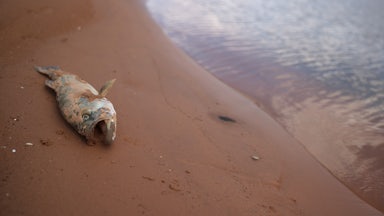The West Coast began 2023 with heavy rainfall. It was a drastic change from what’s becoming the new normal: a dry climate that is affecting everything from residential gardens to long-term water reserves for tens of millions of people. The previous three years recorded the driest levels in 100 years. And while the rain served as a reprieve, it didn’t change those underlying conditions; ultimately, floods too were a reminder of the need to adapt to an increasingly variable climate.
California and Arizona are ramping up plans at present to combat drought and climate change in general. In August 2022, California Governor Gavin Newsom presented an $8 billion plan to boost the state’s water supply by creating new storage for four million acre-feet of stormwater. Arizona’s Katie Hobbs recently announced an initiative that would modernize the state’s groundwater supply and close loopholes that have allowed water to be poached.
Even with these plans, the seven states depending on the dwindling Colorado River for water have yet to agree on a water usage regimen going forward. And so many people are trying to do their part on an individual level. Mulching and skipping the daily lawn watering at home can make a difference if done by thousands. Anything helps. And even your favorite sports teams are trying to pitch in, all while trying to strike the balance between conservation, player safety, and accommodating the fans in attendance.
At a first glance, one would think that the verdant grass fields of your favorite stadium are the major culprit of excess water usage. But the yards of Bermuda grass are only a fraction of a stadium’s total water usage. Drinking fountains, plumbing, and general drainage account for a larger percentage of a venue’s water usage than just the field. “We all want to be water wise and be cognizant of the resources we are using,” Joe Furin, general manager of the Los Angeles Coliseum, told me.
There are differences between residential and commercial water restrictions, however. Because the venue’s business relies on the upkeep of the field and facilities, they don’t have the same water restrictions at the same scale. Residential water restrictions vary from county to county. In some areas of Los Angeles, for example, some homes have been limited to watering their lawns twice a week on specified days depending on their address. On top of that, they are prohibited from watering during midday to avoid evaporation from the sunlight.
For a stadium, the field must be watered frequently leading up to events. This means that the more games an arena hosts, and the more frequently, the more care and water it would need. “It’s driven by the weather and usage. If we don’t have an event for three weeks, that might be a different maintenance program,” Furin said. “Hotter weather would dictate more water. We shuffle according to weather and grass. In a unique way, the consistency of a football season allows us to plan a couple of months out.”
The Coliseum is home to the University of Southern California Trojans college football team. With home games beginning in the fall, Furin and his team can work around the school’s schedule to maintain the field for game days. If the school has a scheduled away game, then the groundskeeping crew can lessen its water use and also let the grass grow taller than they would if the team was at home.
Watering less during the season around home games might also make a difference—but it runs the risk of damaging the quality of play during games and can lead to unfortunate injuries. The issue isn’t so much the grass itself as the condition of the soil. A dry field might prevent a soccer or football player from getting the traction they need to make a sharp turn as they escape defenders. To make sure the field is in an adequate condition to play, a crew tests the soil the day before an event and also on the day of. The adjustment can be minuscule. But a game-defining play can come down to a series of successfully executed jukes and cuts.
An overwatered field can have its own issues. A natural grass field can go through all the proper testing and water but still be inadequate when it’s time for kickoff. This year’s Super Bowl in Arizona showed just that: Although the NFL reportedly spent almost two years and $800,000 on developing a hybrid Bermuda grass, both Philadelphia Eagles and Kansas City Chiefs players complained about the turf’s slippery condition. Eagles tackle Jordan Mailata compared it to “playing on a water park.”
Opting to use artificial turf could have avoided this scenario and saved money and resources. Still, that would have been unlikely given the location of this year’s Super Bowl; a key feature of Arizona’s State Farm Stadium is its retractable playing field, designed so that the natural grass can be rolled outside for sunshine. The Las Vegas Raiders’s Allegiant Field also uses a retractable field to maintain its own natural grass, but it also boasts an artificial turf for the University of Nevada, Las Vegas college football games.
And then there’s also a matter of preference and safety when deciding to play on a natural or artificial turf. The NFL Players Association has been on the record about its choice, recommending that all stadiums switch to natural grass. NFLPA president JC Tretter wrote that the rate of noncontact injuries is significantly higher on artificial turf than on natural grass, citing NFL data from 2012 to 2018. Player safety and water conservation, therefore, can feel like they’re diametrically opposed—but there are ways to incorporate both surfaces.
The Los Angeles Coliseum does not currently have plans to shift the entire playing field from natural to artificial turf. But it is looking into figuring out what parts of the arena can be transformed to maximize its water use. Years ago, Furin and his staff removed the Bermuda grass behind the field goalposts in favor of turf. “We were spending an awful lot of resources to keep these parts of the field maintained. If you’re up above you can’t see where the artificial meets the grass.”
Most NFL stadiums on the West Coast still use natural grass. San Francisco’s Levi’s Stadium, Arizona’s State Farm Stadium, Denver’s Empower Field at Mile High, and Las Vegas’s Allegiant Field all use natural grass. Los Angeles’s SoFi Stadium uses turf, as well as Seattle’s Lumen Field. Washington State is currently not experiencing a drought like its neighboring states, but it is experiencing abnormally drier climates.
These water conservation efforts exist—much like many individual water conservation efforts—in a strange middle ground when it comes to the broader crisis. While any effort to conserve water should be lauded, a sports stadium opting to uproot its sod in favor of an artificial counterpart is symbolic and second to a greater collective action that would save water for millions in the American Southwest. Eighty percent of the Colorado River’s water supply, for example, goes to agriculture, and much of that to alfalfa for feeding cattle, including cattle in other countries. Agriculture reform, not sports reform, is the first place to start when looking to solve the growing Southwestern water crisis.
But football facilities can still have a role to play when it comes to the intractable political problem of Southwestern water negotiations: If America’s most popular sport can adjust its techniques to adapt to a new normal, then so can the people attending the games. And that larger action, and the awareness it builds, might lead to a more water-wise future west of the Rocky Mountains.










